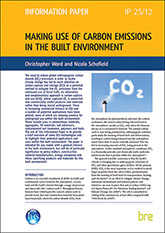
Making use of carbon emissions in the built environment - Downloadable version
The need to reduce global anthropogenic carbon dioxide (CO2) emissions in order to tackle climate change has led to much attention on carbon capture and storage (CCS) as a potential method to mitigate the CO2 emissions from the continued use of fossil fuels. An alternative and complementary approach is carbon capture and use (CCU), where captured CO2 is converted into commercially useful products and materials rather than being stored underground. There is increasing commercial interest in CCU and a number of potential applications have been piloted, some of which are showing promise for widespread use within the built environment. These include uses in cementitious materials, aggregates, fill materials, soil enhancers, contaminated soil treatment, polymers and fuels. The aim of this Information Paper is to provide a brief overview of some CCU technologies and to highlight their potential applications and uses within the built environment. The paper is intended for any reader with a general interest in the built environment, but will be of particular significance to policy makers, construction material manufacturers, energy companies and those specifying products and materials for the built environment.
CONTENTS
Introduction
Carbon capture and storage
Carbon capture and use
-Mineral carbonation
-Chemical conversion
-Enhanced biological conversion
-Cementitious materials
-Aggregates, fill material, soil enhancers and treatment of contaminated soils
-Polymers
-Fuels
-Other carbon stores
Challenges of carbon capture and use
References
A4 8pp
20 December 2012
2 line drawings, 3 photo's
